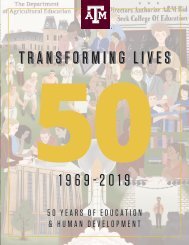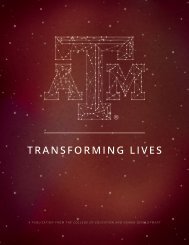2018 Transforming Lives - Developing Translational Research and Transformational Leaders
Create successful ePaper yourself
Turn your PDF publications into a flip-book with our unique Google optimized e-Paper software.
Dr. Bailey said helping SAAHE students develop the<br />
knowledge, skills <strong>and</strong> self-awareness to provide inclusivity<br />
on campus is a theme seen throughout all the classes in<br />
the program.<br />
A recent graduate, Metzmaker references the cohort<br />
structure as a major deciding factor for choosing Texas<br />
A&M.<br />
“A lot of the background of our profession is in social justice<br />
<strong>and</strong> social equity. We have to make sure every student is<br />
receiving the same services,” Frazier said.<br />
In his assistantship, Frazier provides academic coaching,<br />
advises two student organizations <strong>and</strong> manages learning<br />
communities. His assistantship helps him underst<strong>and</strong> the<br />
full scope of student affairs.<br />
“My assistantship is more representative of what student<br />
affairs actually is,” Frazier said. “When you generally<br />
think about student affairs, you think student activities,<br />
multicultural affairs <strong>and</strong> resident life <strong>and</strong> things like that<br />
where you are more focused on campus engagement.”<br />
His work at the Byrne Center allows him to focus on these<br />
areas while also helping students succeed academically.<br />
“To be able to sit down with a student <strong>and</strong> say, ‘Hey, I’m<br />
focused on you. Let’s figure out what you need to make<br />
this experience better for you.’ That’s where most of the<br />
fulfillment comes,” Frazier said.<br />
Dr. Louis Ponjuan meets with SAAHE students on campus.<br />
“Looking at different graduate programs, I felt that Texas<br />
A&M would offer a lot of opportunities due to how big the<br />
school is. Within the SAAHE program, I felt that I would<br />
feel more at home because it is a small cohort setting,”<br />
Metzmaker explained.<br />
“Through the cohort model, we take courses together<br />
<strong>and</strong> have transition meetings once a month,’ Metzmaker<br />
said. “[During these meetings], we share what issues we<br />
are dealing with, how to best support each other in those<br />
situations <strong>and</strong> what we can do to be our best selves.”<br />
“WE ASK STUDENTS TO CHALLENGE THEMSELVES,<br />
TO THINK DIFFERENTLY, TO PUT THEMSELVES IN<br />
PLACES OF DISCOMFORT, AND LEAN INTO THAT<br />
SO THEY CAN LEARN MORE. WE WANT THEM TO<br />
LEAVE DIFFERENT THAN WHEN THEY CAME.”<br />
Dr. Krista Bailey, SAAHE Director<br />
COLLABORATION IN A COMMUNITY<br />
Every year, 14-18 students come in as a cohort <strong>and</strong> go<br />
through the program together. The group takes the same<br />
classes <strong>and</strong> graduates at the same time. Frazier described<br />
the cohort as a family, a network of support that turns a<br />
campus of 68,000 into a campus of 18.<br />
“We do a lot of group work <strong>and</strong> a lot of collaboration in<br />
the first semester. It helps us get to know each other. It<br />
reinforces the idea that student affairs is a profession of<br />
collaboration,” Frazier said.<br />
Steven Metzmaker came to Texas A&M from Minnesota. He<br />
spent his undergrad at Loyola University in Chicago <strong>and</strong>,<br />
after traveling abroad, spent two summers at Columbia<br />
University in New York.<br />
FELLOWSHIP WITH FACULTY<br />
The faculty become a part of the cohort while also leading the<br />
learning <strong>and</strong> support of the students. Each faculty member<br />
has some prior experience as a student affairs practitioner.<br />
They pull from experiences in the field <strong>and</strong> incorporate it<br />
into their lesson plans, using real world examples to bring<br />
underst<strong>and</strong>ing to theory.<br />
As director, Dr. Bailey forms a special mentoring relationship<br />
with each student. She often meets one-on-one each<br />
semester to hear an update on the student’s progress. She<br />
said these meetings help her tailor the program to meet the<br />
needs of the students.<br />
“We ask students to challenge themselves, to think<br />
differently, to put themselves in places of discomfort, <strong>and</strong><br />
lean into that so they can learn more,” Dr. Bailey said. “We<br />
want them to leave different than when they came.”<br />
TO LEARN MORE ABOUT THE TEXAS A&M UNIVERSITY<br />
STUDENT AFFAIRS ADMINISTRATION IN HIGHER EDUCATION<br />
GRADUATE PROGRAM VISIT SAAHE.TAMU.EDU<br />
18





